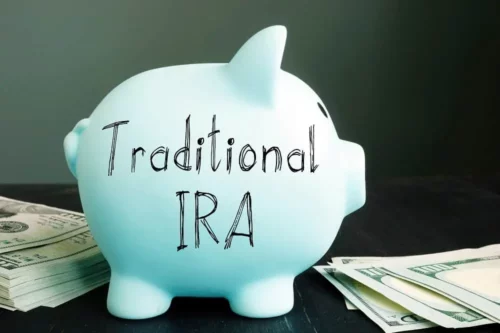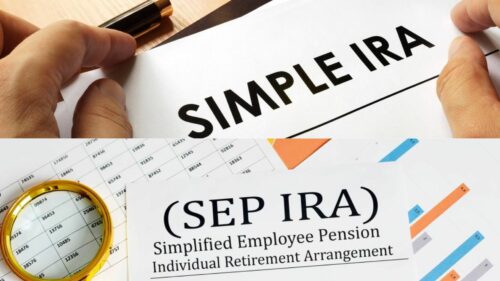This is part of a series. If you have not read the articles that build up to this one, I recommend that you do so first.
- Answering the Question Why About Your Money
- Monkey Brain’s Common Weapons
- Money Comes and Money Goes
- Cracking the Whip on Your Money
- A Contract on Your Life
- What if You Can’t Work (and Not Just From a Lack of Coffee)?
- Don’t Pay an Arm and a Leg to Keep Your Arm And Leg
- Long Term Care Insurance
- Investing Doesn’t Mean Playing the Markets
The quickest way to double your money is to fold it over and put it back in your pocket.
–Will Rogers
Once upon a time, saving for retirement meant working in the fields or in the village until you dropped over dead. Then, eventually, civilization progressed (supposedly), to where you worked at a company until they gave you a company watch and a pension, and Social Security was there to cover the gaps.
Nowadays, according to the United States Bureau of Labor and Statistics, just 8% of private companies provide a defined benefit pension plan – the one that you typically think of where you get a retirement check for the rest of your life.
Given that there’s a paucity of guaranteed pensions and that, according to the Social Security Administration, Social Security is only supposed to replace about 40% of an average earner’s wages, you need to take the responsibility for putting a roof over your head, food in your mouth, and clothes on your back after you retire, or you need to plan to work until you keel over at your desk (or in the field or in the village), a la how your great^20 grandparents did retirement planning.
How Do I Save for Retirement

The federal government decreed that it was good for us to not spend all of our money now so that we’d have some left over later. So, it enacted Social Security. The catch with Social Security was that, when it was enacted, people were expected, on average, to die right about the time they became eligible for Social Security. Not many people would keep on ticking, so the program seemed to be in pretty good shape.
Then medicine caught up to the government’s well laid plans, and we started living longer. The magic age of 65 had been mandated (it was, after all, the average life expectancy at the time), and so we started retiring and expecting Social Security to keep up with us.
For a while, it did. Then, the ratio of workers to retirees started dropping, and relying solely on Social Security as the only source of retirement income became impractical for most seniors.
Thus, the government decided to create a separate category of tax-advantaged shelters where you could stash away money and then, starting at age 55 to 59 ½, withdraw that money either tax free, or having not paid taxes on the growth the entire time the money was in the accounts.
Welcome to the world of the Individual Retirement Arrangement (IRA).
We’ll actually cover more than just IRAs in this article. We’ll cover other qualified tax deferral plans like 401ks, 403bs, ESOPs, and TSPs.
First, though, let’s cover the one that most people know about and are familiar with.
IRAs
In practical terms, an IRA is an account where you put money in, invest it, and get some sort of tax advantage in doing so.
There are two types of IRAs.
Roth IRA
You fund a Roth IRA with after-tax dollars, meaning no tax deduction for what you contribute to the account, but when you withdraw funds later, you do not pay taxes on the growth. You pay taxes now, and you don’t pay taxes later.
Sounds great, right? Sign me up!
There’s a catch. You can’t make too much money. If your modified adjusted gross income is more than certain limits, you’re ineligible to contribute to a Roth IRA.
| If your filing status is… | And your modified AGI is… | Then you can contribute… |
| married filing jointly or qualifying widow(er) | < $196,000 | up to the limit |
| > $196,000 but < $206,000 | a reduced amount | |
| > $206,000 | zero | |
| married filing separately and you lived with your spouse at any time during the year | < $10,000 | a reduced amount |
| > $10,000 | zero | |
| single, head of household, or married filing separately and you did not live with your spouse at any time during the year | < $124,000 | up to the limit |
| > $124,000 but < $139,000 | a reduced amount | |
| > $139,000 | zero |
Amount of your reduced Roth IRA contribution
If the amount you can contribute must be reduced, figure your reduced contribution limit as follows.
- Start with your modified AGI.
- Subtract from the amount in (1):
- $196,000 if filing a joint return or qualifying widow(er),
- $-0- if married filing a separate return, and you lived with your spouse at any time during the year, or
- $124,000 for all other individuals.
- Divide the result in (2) by $15,000 ($10,000 if filing a joint return, qualifying widow(er), or married filing a separate return and you lived with your spouse at any time during the year).
- Multiply the maximum contribution limit (before reduction by this adjustment and before reduction for any contributions to traditional IRAs) by the result in (3).
- Subtract the result in (4) from the maximum contribution limit before this reduction. The result is your reduced contribution limit.
(table above sourced from IRS)
Roths also have some special rules for withdrawals. First, they are not subject to required minimum distributions (RMDs), which we’ll see in traditional IRAs. Secondly, you can withdraw any direct contributions (e.g. money which you put into the account rather than rolled over from another retirement account such as a 401k or 403b) at any time tax free. Thirdly, if you’ve owned the IRA for more than 5 years, you can withdraw both contributions and earnings tax and penalty free for higher education expenses, $10,000 for a down payment for a first home, or for medical or hardship expenses. If you withdraw earnings before age 59 ½ for any other reason, you will pay a 10% penalty on your withdrawals.
Whether or not you should withdraw early is another matter. The short answer is that, unless you’re going to starve, lose your house, or not get needed medical treatment (no, not the Joan Rivers facelift), you shouldn’t. That’s what your emergency fund is for.
Once you reach age 59 ½, you’re eligible to withdraw money from your Roth IRA at any time tax free. You are not required to do so.
As long as you continue working, you can contribute to your Roth IRA. You must have earned income, e.g., wages, salaries, self-employment income, commissions, alimony/separate maintenance payments, and non-taxable combat pay. If you do not have earned income, you cannot contribute to a Roth IRA.
As you draw down your Roth IRA, the amount that you withdraw does not count against your means testing for either Medicare Part B fees or for adjustments to your Social Security taxation. It’s not treated as income by the IRS, so it does not affect those two calculations, as both Medicare Part B means testing and Social Security taxation are affected by your income.
Roth IRAs also pass on to your heirs federal income tax free. They avoid probate. The recipient of an inherited Roth must choose whether or not to receive distributions throughout his or her lifetime or to wait five years and take a lump sum (almost always, the former case will be better).
It is also possible to convert traditional IRAs to Roth IRAs by paying taxes on the amount converted. This is a good idea if you have a year when your taxes are particularly low (for example, you took a year off of work) AND you have the available liquid funds outside of your retirement accounts to pay the taxes. However, in 2017, the tax reform bill changed the rules about recharacterizing conversions, so now, you only get one shot, and if you recharacterize too much and put yourself in a new tax bracket, you’ll have to pay additional taxes that you would not have otherwise needed to pay.
Traditional IRA

A traditional IRA differs from the Roth IRA in that you don’t pay taxes on the money in the IRA until you withdraw. In most instances, you take a deduction from your taxes in the year in which you make a contribution to the traditional IRA. The only time that you cannot take a deduction from your taxes for a traditional IRA contribution is when either you or your spouse has a retirement plan with your employer – regardless of whether or not you actually contribute to the plan – and you exceed certain income thresholds.
| If Your Filing Status Is… | And Your Modified AGI Is… | Then You Can Take… |
| single or
head of household |
$65,000 or less | a full deduction up to the amount of your contribution limit. |
| more than $65,000 but less than $75,000 | a partial deduction. | |
| $75,000 or more | no deduction. | |
| married filing jointly or qualifying widow(er) | $104,000 or less | a full deduction up to the amount of your contribution limit. |
| more than $104,000 but less than $124,000 | a partial deduction. | |
| $124,000 or more | no deduction. | |
| married filing separately | less than $10,000 | a partial deduction. |
| $10,000 or more | no deduction. | |
| If you file separately and did not live with your spouse at any time during the year, your IRA deduction is determined under the “single” filing status. | ||
If you file separately and did not live with your spouse at any time during the year, your IRA deduction is determined under the “single” filing status.
Even you don’t qualify to deduct your contribution from your income taxes, you can still contribute to a traditional IRA.
The rules for contributing to and withdrawing from a traditional IRA are different than the rules for a Roth IRA.
First, you cannot withdraw your contributions without paying a 10% penalty unless the withdrawal is for a specific set of circumstances, such as first time home purchase (e.g. you didn’t own a principal residence in the past two years), school, and medical hardships.
Secondly, you cannot contribute to a traditional IRA after age 72, which differs from a Roth IRA, where you can contribute regardless of your age.
Thirdly, after you reach age 72, you need to start taking required minimum distributions (RMDs). You must take a RMD by the April after you turn 72, or you will face a STEEP penalty. The excise penalty for failing to take the appropriate RMD is 50% of whatever you should have taken. For example, let’s say that your RMD was $10,000 and you only took out $6,000. You would have a RMD shortfall of $4,000. The IRS would impose a $2,000 penalty on you (50% of $4,000) for failing to take the RMD. It’s no joke.
You can calculate your RMD by using the RMD tables provided by the IRS. There are two tables; you need to pick the one which applies to you:
- Joint and Last Survivor Expectancy Table – if your spouse is the sole beneficiary and is more than 10 years younger than you.
- Uniform Lifetime Table – Everyone else.
The year after you turn 72 is tricky for a second reason. You have to take another RMD by that December.
So, if Joe turns 72 on May 1, 2020, then he needs to take his first RMD by April 1, 2021, and he has to take a second RMD by December 31, 2021. After that, he has to take an annual RMD by December 31 of each subsequent year.
The RMD is a required minimum distribution. You’re allowed to take out more than the minimum if you need or want to.
If you make a contribution to a traditional IRA and are not allowed to deduct your contribution, then that amount becomes part of your basis, meaning you will not be taxed for that percentage when you withdraw.
For example, if Jean makes a $5,000 contribution, and $3,000 is not deductible, then her basis is $3,000. When she turns 59 ½, her account value is $10,000. She decides to make a $1,000 withdrawal. Since her basis was 30% of the total account value, she will be taxed on $700 of the withdrawal at ordinary income tax rates.
SEPs and SIMPLEs

Simplified Employee Pension IRAs (SEP) and Savings Incentive Match PLan for Employees (SIMPLE) are forms of IRAs offered by employers. Simplified Employee Pension IRAs (SEP) and Savings Incentive Match PLan for Employees (SIMPLE) are forms of IRAs offered by employers. For a SIMPLE, you can contribute up to $13,500 in 2020, and if you’re 50 or older, you can contribute up to $16,500. Total deferrals in salary-deferred retirement plans (e.g. 401k or 403b plans) cannot exceed $19,500 in 2020, or $26,000 if you’re 50 or older.
Your employer must either:
- Match your salary contributions dollar for dollar up to 3% of your total compensation, or
- Contribute a straight 2% regardless of whether or not you’re contributing
SEP plans only allow employer contributions, so they’re good for self-employed people. For a self-employed individual, contributions are limited to 25% of your net earnings from self-employment, up to $57,000.
Total defined contribution plan deferrals (e.g. 401k, SEP, profit-sharing) cannot exceed 25% of your net earnings from self-employment, not to exceed $57,000.
In almost all other aspects, SEPs and SIMPLEs are treated like a traditional IRA. The one exception is for early withdrawals from a SIMPLE. If you make a withdrawal from a SIMPLE within first two years of participating in it, the IRS will levy a 25% penalty rather than the usual 10% penalty. Ouch.
(again, source)
401ks, 403bs, and 457 plans
401k, 403b, and 457 plans are tax sheltered retirement plans where both you, the employee, and your employer can fund the plans. They are generally similar plans, and will be treated as such in this section unless specifically noted. Public and private sector employers can establish 401k plans. State and local governments and tax-exempt organizations establish 457 plans. Schools, churches, hospitals, charities, research institutes, and other non-profits establish 403b plans.
The contribution limits for the plans are defined below.
| Type of Plan | Annual Contribution Limit | Catch up Provision (Amount Beyond the Contribution Limit You Can Contribute in a Year) |
| 401k | Your contributions: $19,500
Total contributions (including early contributions): $57,000 |
Age 50 and over, $6,500 |
| 403b | Your contributions: $19,500
Annual limit on employee + employer contributions: $57,000 |
Age 50 and over, if allowed by the plan: $6,500
If permitted by the 403(b) plan, an employee that has at least 15 years of service with a public school system, hospital, home health service agency, health and welfare service agency, church, or convention or association of churches (or associated organization), his or her 403(b) elective deferral limit is increased by the lesser of:
|
| 457 | The lesser of: | If permitted by the plan, for 3 years prior to the normal retirement age (as specified in the plan), the lesser of:
Additionally, 457(b) plans of state and local governments may allow catch-up contributions for participants who are aged 50 or older. |
You can select to treat these plans as either Roth or traditional contributions. If you choose the Roth option, then you will fund these plans with after-tax money. When you make withdrawals, you will not have to pay taxes on the earnings, since you already paid taxes on the money used to fund the accounts. If you choose the traditional option, then you will make contributions with pre-tax funds, meaning that you will lower your AGI, but when you withdraw the funds, you will pay ordinary income tax rates on those funds.
Employer matches are always done with pre-tax money, so if you choose a Roth option for your retirement account, then there will be two separate accounts – one for your contributions and one for the employer match.
Once you’ve contributed to the retirement plans, there will generally be a menu of investment options to choose from. Some retirement plans are better than others, but if you’re receiving a matching contribution, then even if you’re paying a high fee on the money that you’re investing, it’s still a good deal, since you’re getting a 100% return on your vested matching funds. Where possible, you’re going to want to invest in index funds, including your employer sponsored retirement plan into your overall asset allocation picture.
When it comes time to retire, the withdrawal options are slightly different than for an IRA. Generally, if you have a traditional plan, you will be required to start taking withdrawals by the April first after you reach age 72, but some plans will allow you to avoid the RMD until you actually retire from the company (unless you own 5% or more of the company). See the previous section for RMD tables. The 50% excise tax also applies to missing your RMDs for these retirement plans. Note: If you have a Roth 401k and it remains with your company after you leave, then you are required to take RMDs from it once you reach age 72; however, the easiest solution for that problem is to roll your Roth 401k into a Roth IRA.
Additionally, you are allowed to start taking withdrawals from these accounts when you reach age 59 ½ if you are still working. If you have retired, once you reach age 55, you can start withdrawing from these accounts penalty-free. Unqualified withdrawals prior to that point have a 10% excise penalty against them.
If you have a Roth retirement plan, you cannot withdraw the contributions penalty free like you can with a Roth IRA. Furthermore, money in a Roth retirement plan must be there for five years before you can withdraw it, regardless of your age.
It is possible to take a loan out against these plans if your plan provider allows for them. There are rules about the limit that you can take out and the payback period. You should only take out a loan from your plan if not doing so will make you starve, lose your house, or not receive life-sustaining medical care. Otherwise, figure out another way to earn more income. The reason that these loans are bad are twofold:
- You’re taxed twice. First, you repay the loan with after-tax money, converting pre-tax money (in the case of a traditional retirement plan) to after-tax money while still paying taxes on the withdrawals.
- If you leave your job, the loan will be called in full. If it’s not paid off within the prescribed time period, the IRS will consider it a distribution and tax you on it as well as, if applicable, slapping a 10% early withdrawal penalty on it.
You can also read 4 Reasons to Avoid 401k Loans for more information on why taking out loans on your retirement plans is not a good idea.
Rollovers

Once you leave an employer, you are eligible to roll your accounts over to a different retirement plan. The IRS has a handy chart to help you figure out what accounts are eligible to be rolled into different accounts, so rather than rehash them, I’ll have you check out the IRS’S rollover chart.
We recommend rolling employer sponsored retirement plans into IRAs because they give you more control over what you invest in (low cost indexed mutual funds, right?) and don’t charge you an annual maintenance fee. It’s more convenient to have the funds in one account in one place than to try to keep track of all of the different accounts and plans, particularly if you switch employers frequently.
There are two reasons why you would keep your money in an employer sponsored retirement account:
- You expect to be sued. Creditors cannot come after employer sponsored retirement accounts, as they are protected by ERISA laws. If you have a good umbrella liability insurance plan (I recommend having liability coverage of at least 125% of your net worth so that the lawyers go after the liability insurance rather than you), then you’ll be covered in most cases.
- You plan on retiring earlier than age 59 ½. Remember, the withdrawal rules for IRAs and for employer sponsored plans are different. You can withdraw from an employer sponsored plan at age 55 without paying a penalty, whereas with an IRA, you have to wait until age 59 ½. Keeping money in an employer sponsored retirement plan will give you 4 ½ years of additional access to funds that you’ll probably want to tap for expenses.
Thrift Savings Plans
If you’re a federal employee, then you have the opportunity to invest in a Thrift Savings Plan (TSP). The TSP is designed to mimic the 401k program in many of its aspects. If you’re a civilian employee, then you can designate either a percentage of your paycheck or a specific amount to be contributed each month. If you’re in uniform, then you designate a percentage of your paycheck. Uniformed servicemembers can also elect to contribute between 1% and 100% of their incentive pay, bonus pay, or special pay to the TSP as long as they are contributing some percentage of their regular pay. The contribution limitation is $19,500 per year, with a $6,500 catch up provision for age 50 or older. There are special rules for contributions for service members who are in an active combat zone and receiving a combat zone tax exclusion. Some agencies will conduct an automatic 1% contribution and do matching contributions. The total contributions between employee and employer contributions in a given year cannot exceed $57,000 in 2020.
Once you have contributed to the TSP, this is where it gets good. I normally won’t say that the government does a lot of things well, but it has nailed your investment choices. You get a choice of five different investments:
- G Fund: The government securities index fund
- F Fund: The fixed income index fund – tracks the Blackrock U.S. Debt Index Fund
- C Fund: The common stock index fund – tracks the Blackrock Equity Index Fund
- S Fund: The small capitalization stock index fund – tracks the Blackrock Extended Market Index Fund
- I Fund: The international stock index fund – tracks the Blackrock EAFE Index Fund
Why do I love these?
SUPER LOW EXPENSE RATIOS! Yes, you will pay 0.01% as an expense ratio if you own these funds. Comparatively speaking, Vanguard, vaunted as the low cost index fund kings, has an expense ratio 11 times higher than the government’s funds.
This means that for every $100 you contribute, $99.99 actually goes into investments. There’s no better option out there for investors.
The withdrawal rules for a TSP have some similarities to employer sponsored benefits plans. You must take withdrawals by April 1 after you turn age 72, even if you have a Roth TSP. You can withdraw starting at age 59 ½ if you’re still working, and age 55 if you’re retired. If you withdraw before then, you pay a 10% penalty. You can also take out loans, but the same rules and caveats as with employer sponsored retirement plans apply. If you are still working for a federal employer when you reach age 59 ½, you are allowed to take one withdrawal while still working, and the government will withhold 20% for taxes.
Once you have retired and are ready to draw down on your TSP, you have several options for withdrawing the money:
- One-time payment. Get a lump sum check. Go to Vegas (OK…not really).
- Full withdrawal as a series of payments. You can choose the series of payments in two forms:
- Specific dollar amount. You get to say how much per month gets withdrawn (must be $25 per month or more). You can change the amount once per year. If you do not take an annuity, this is the method I recommend because you are able to control the amount which is withdrawn. You can read about annuity strategies in “Annuity Dollar Cost Averaging.”
- Drawdowns based on life expectancy. This is like the RMD distribution for an IRA. The IRS figures out a factor based on your or you and your spouse’s joint life expectancy and divides your account balance by that number. They then distribute an equal amount monthly. The amount distributed will change every year, but the formula won’t.
- An Annuity. At any point, you can use your remaining balance to purchase a life annuity. You must have a balance of at least $3,500 for this option. I recommend you price out private sector annuity rates before choosing this option; while the index funds offer superior pricing, I have found that the federal annuity rates usually underperform. Most of the time, you’d be better off taking a lump sum payment and purchasing an annuity privately.
Pensions

I’ll cover pensions very briefly, as they are employer sponsored payment programs rather than employer sponsored retirement accounts which you contribute to.
There are two main types of pension account:
- Defined contribution: these are pension accounts designed to have your account funded with a certain amount of money based on the contributions and the assumed rate of return.
- Defined benefit: these are pension accounts designed to give you a certain periodic payout based on how much you earned in wages and how long you worked for the employer.
The key terms to know with pensions are how much you’re supposed to get and at what time you’re supposed to get it. Those are key in your retirement planning, as they will represent a stream of income, much like Social Security (but hopefully larger) once you reach a certain age. There will usually be vesting periods involved with the pension programs – as an example, when I was in the Army, if I would have served for 20 years, I would have received a military pension. With a few exceptions, anything less than 20 would earn me no pension whatsoever.
There are also a few frequently asked questions that we can address for you below.
What Retirement Plans Offer Tax Benefits?
The short answer is that all retirement plans offer tax benefits. The primary question is whether or not they offer tax benefits now or when you retire.
Roth retirement plans (either individual retirement accounts, aka IRAs, or defined contribution accounts, such as 401ks) offer a tax benefit when you retire. You pay taxes on the amount that you contribute to a Roth account now in exchange for not having to pay taxes on what you hope is the gain in value later. Roths can also be passed on through your estate tax free to your heirs.
Traditional retirement plans generally offer tax benefits now in that, assuming you qualify, you get a tax deduction on your contribution now, but, later, you will need to pay taxes when you withdraw from those accounts. Traditional retirement accounts may incur estate taxes when they pass through your estate to your heirs.
How Much to Save for Retirement?

The answer to this question is a function of two variables:
- How long do you plan to retire? The longer you plan to retire, the more you have to save. Our research shows that you need to save 25.6 times your annual expenses if you plan on retiring for 30 years, 27 times your annual expenses if you plan on retiring for 40 years, and 28.6 times your annual expenses if you plan on retiring for 50 years. Naturally, your mileage and future market performance may vary and cause this number to fluctuate. This does segue, though, into the second variable.
- What are your annual expenses? These expenses aren’t just your everyday expenses like food, housing, and gas, but, also, your irregular expenses, like car insurance and the holidays, which you know are coming but aren’t always top of mind. Also, your expenses may change in retirement. Do you have to commute to work every day now? Do you have to wear business or business casual attire? If so, your expenses may decrease. Will you travel more? Take up expensive hobbies like 100/200 no limit poker? If so, your expenses may increase. You should develop a retirement budget based on the lifestyle you expect to live when you get there. If you need help, then find a financial planner near you to work with you on that budget to determine how much your baseline spending is so that you can apply the multiple defined above. Finally, even if you know how much you’re going to spend based on where you are, you may decide to move somewhere else, whether it is to be closer to family, be closer to activities you like to pursue, or for a cheaper cost of living. Therefore, how much you need to save for retirement depends on where you plan to live. Click on this link to find out the average cost of living and expected required retirement savings for your city and compare it to where you want to live. Again, if you need help, you can find a financial planner near you to assist you in these calculations.
Is It Too Late to Save for Retirement?
No. It is never too late to save for retirement. There may eventually come a time when you cannot work, and the more that you have saved up, the more you will be able to rely on to supplement your income outside of Social Security. Remember, Social Security was only designed to replace 40% of an earner’s wages, so, unless you’re bringing home 2.5 times what you’re spending, you’re going to need to replace some of your income, or you’re going to have to decrease your lifestyle. Then again, if you’re earning 2.5 times what you’re spending, you’re not asking if it is too late to save for retirement, as you’re already saving 60% of your take-home pay!
For those who need to start, I have two recommendations:
- Start with small wins. Find a way to save $50 or $100 next month. Cut a subscription. Don’t get a haircut and use clippers at home instead. Whatever it is that gets you that small win, give yourself the ability to succeed and show that you can do it. You didn’t get to this point overnight, and you won’t get to the point where the habit of saving what you need to save is ingrained overnight, either.
- Focus intensely on the couple of things that you spend on which bring you the most joy. If your goal is to maximize your joy, then, once you focus on that goal and identify the few things that truly bring you joy or bring you closest to joy, you’ll find that you’re frittering away money on things which do not truly bring you joy. That type of focus in your life will help you prioritize your spending, and you should be able to find areas in your budget where you can cut back your spending and save more.
How to Save for Retirement If You Are Self-Employed
I find that there are three plans that are best for self-employed people, which are described earlier in this article:
- SEP
- SIMPLE
- Solo 401k plan (which is a specialized version of the 401k plan described above)
If you are self-employed and bringing in significant amounts of income, then you can leverage more advanced financial planning strategies. If you are in that situation, then we recommend that you find a financial planner near you for a consultation on these more advanced strategies.
Author Profile
- John Davis is a nationally recognized expert on credit reporting, credit scoring, and identity theft. He has written four books about his expertise in the field and has been featured extensively in numerous media outlets such as The Wall Street Journal, The Washington Post, CNN, CBS News, CNBC, Fox Business, and many more. With over 20 years of experience helping consumers understand their credit and identity protection rights, John is passionate about empowering people to take control of their finances. He works with financial institutions to develop consumer-friendly policies that promote financial literacy and responsible borrowing habits.
Latest entries
 Low Income GrantsSeptember 25, 2023How to Get a Free Government Phone: A Step-by-Step Guide
Low Income GrantsSeptember 25, 2023How to Get a Free Government Phone: A Step-by-Step Guide Low Income GrantsSeptember 25, 2023Dental Charities That Help With Dental Costs
Low Income GrantsSeptember 25, 2023Dental Charities That Help With Dental Costs Low Income GrantsSeptember 25, 2023Low-Cost Hearing Aids for Seniors: A Comprehensive Guide
Low Income GrantsSeptember 25, 2023Low-Cost Hearing Aids for Seniors: A Comprehensive Guide Low Income GrantsSeptember 25, 2023Second Chance Apartments that Accept Evictions: A Comprehensive Guide
Low Income GrantsSeptember 25, 2023Second Chance Apartments that Accept Evictions: A Comprehensive Guide

